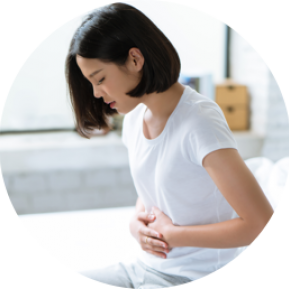Health Care Professionals
PHGG has a specific mode of action in the gut that improves regularity (frequency & consistency)
PHGG has a specific mode of action in the gut that improves regularity (frequency & consistency)
Rao TP, Quartarone G. Nutrition 2019; 59: 158-169.
Slavin J. Nutrients 2013; 5: 1417-1435.
PHGG fiber resists digestion in the small intestine and then travels to the large intestine, where it is slowly fermented by intestinal bacteria. The bacteria in the colon ferment PHGG fiber and produce compounds called short chain fatty acids (SCFAs); including acetate, butyrate and propionate. SCFAs are used by the body as a preferred fuel for colonocytes (colon cells) and may also be used as an energy source for other cells. During the process of fermentation, the SCFAs lower the pH of the intestinal tract. The low pH favors the selective growth of beneficial bacteria including Lactobacilli and Bifidobacterium (this is known as a prebiotic effect). SCFAs further work to stimulate peristalsis; a set of propulsive contractions that occurs in the intestines and moves food through the digestive system. Transit time is also accelerated. This coupled with the increased bacteria mass from fermentation and increased fecal bulk/weight contribute to the regularity or frequency of bowel movements. Finally, SCFAs enhance fluid and sodium absorption in the colon, which helps to normalize the consistency of stool. Stool that is passed is therefore, neither too hard nor too soft.
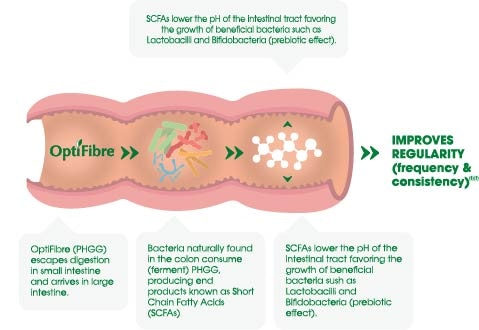
PHGG softens feces and increases the frequency of defecation in constipated women.
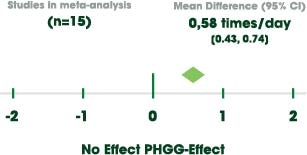
PHGG softens feces and increases the frequency of defecation in constipated women.
Takahashi H, et al. J Nutr Sci Vitaminol (Tokyo). 1994 ; 40(3) :251-259.
In 15 women (18-48 yrs.) who suffered from constipation, the addition of 11 grams of PHGG, given twice daily after meals for 3 weeks (22 grams total PHGG), resulted in an increase in defecation frequency from 0.46 +/- 0.05 to 0.63 +/- 0.05. (frequency/day, average +/- standard deviation). Fecal moisture significantly increased from 69.1% in the control period to 73.8% after ingestion off PHGG. This fecal moisture increased in line with the decrease in the pH of the feces (r = -0.478).
PHGG Increases the Frequency of Defecation in Healthy Subjects
Kapoor M.P., et al. Journal of Functional Foods. 2017; 33 : 52-66.
In healthy adults with constipation conditions, PHGG improved the frequency of defecation. A systematic review and meta-analysis pooled the effects of PHGG from a total of 15 controlled studies that examined pre- and post-PHGG intervention changes in fecal defecation frequency with dosages reported from 5-36 grams per day. In comparison to a control treatment with no PHGG, those who received PHGG as a supplement had a significant change in the number of bowel movements daily. Healthy subjects had about one-half more bowel movements (BMs) per day (or 1 more BM every 2 days) compared to controls (0.58 times/day), p < 0.00001.
PHGG Improves Colonic Transit Time in Chronically Constipated Patients
PHGG Improves Colonic Transit Time in Chronically Constipated Patients
Polymeros D, et al. Dig Dis Sci 2014; 59(9): 2207-2214.
Martelli H, et al. Gastroenterology 1978; 75: 612-618.
In a prospective study with 39 chronically constipated patients, 5 g/day of PHGG for 4 weeks reduced colonic transit time. Colonic transit time was significantly reduced by about 12 hours from the pre-treatment period with no PHGG to the end of the 4-week PHGG treatment period, (57.28 ±39.25 hrs. vs. 45.63±37.27 hrs.), p=0.026.
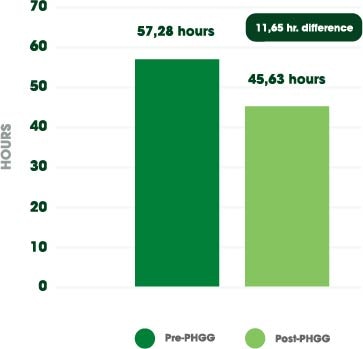
PHGG Reduces the Number of Bowel Movements with Straining and Increases the Number of Spontaneous Bowel Movements
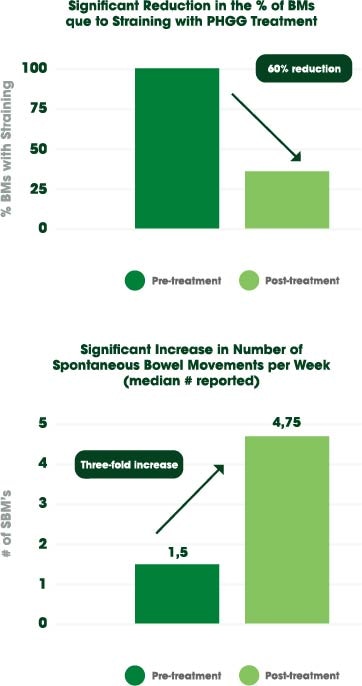
PHGG Reduces the Number of Bowel Movements with Straining and Increases the Number of Spontaneous Bowel Movements
Polymeros D, et al. Dig Dis Sci 2014; 59(9): 2207-2214.
In 39 adults with chronic constipation, 5 g/day of PHGG for 4 weeks led to over a 60% reduction in the percentage of bowel movements due to straining (100% vs. 38%, pre-treatment vs. post-treatment) and a three-fold increase (1.5 vs. 4.75, pre-treatment vs. post-treatment) in the number of spontaneous bowel movements per week, p < 0.001).
PHGG Increases the Growth of Beneficial Bacteria
PHGG Increases the Growth of Beneficial Bacteria
Takahashi et al. J. Nutr. Sci. Vitaminol.(Tokyo) 1994; 40 (3): 251-259.
Okubo et al. Biosci. Biotech. Biochem. 1994; 58 (8): 1364-1369. Carlson et al. Anaerobe. 2016; 42: 60-66.
In three studies, PHGG significantly increased beneficial bacterial species compared to baseline:
Study 1: In 15 constipated women, 11 grams of PHGG daily for 3 weeks resulted in an increase in Lactobacillus species in feces from 33% to 67% (control period vs. week 3).
Study 2: In 9 healthy adults, 7 grams of PHGG daily for 2 weeks resulted in an increase in Bifidobacterium spp. In total bacterial cell counts from 14.7% to 31.7% (control period vs. week 3).
Study 3: Fecal samples from 6 healthy donors were exposed to 0.5 grams PHGG and measured for bacterial changes. Results showed parabacteroides increased from 3.48% to 10.62% and bacteroides spp. From 27% to 33% (Baseline vs. 24 hours).
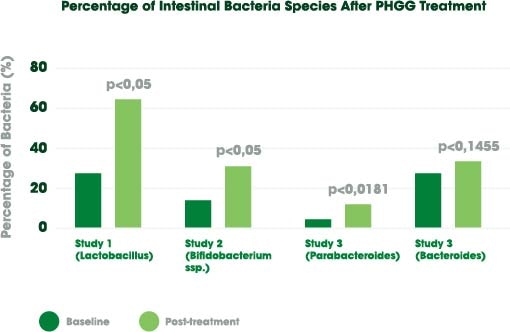
In 21 Nursing Home Residents, Supplementation with PHGG Fiber Reduced Laxative Use after 8 Weeks
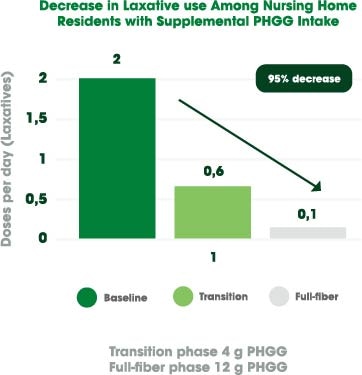
In 21 Nursing Home Residents, Supplementation with PHGG Fiber Reduced Laxative Use after 8 Weeks
Patrick P.G. et Coll. Am Diet Assoc 1998; 98(8):912-4
In elderly nursing home residents, laxative use is common on a regular basis to help with constipation relief. In a study by Patrick et al. PHGG was supplemented in the diet starting with a 4 gram per day dose and gradually increased to 12 grams per day for a total supplementation period of 8 weeks. After 8 weeks, PHGG fiber supplementation reduced laxative use by 95% from the baseline period to the end of the 8-week study period.
Five Grams of PHGG Daily for Twelve Weeks Helps Manage Flatulence, Bloating and Cramping
Five Grams of PHGG Daily for Twelve Weeks Helps Manage Flatulence, Bloating and Cramping
Giaccari S et al. PHGG: La Clinica Terapeutica 2001; 152: 21-25.
In 90 patients with Irritable Bowel Syndrome (IBS), PHGG significantly reduced symptoms including flatulence from 71.6% to 3.3%, bloating from 53.7% to 3.3% and cramping from 54.5% to 4.4%.
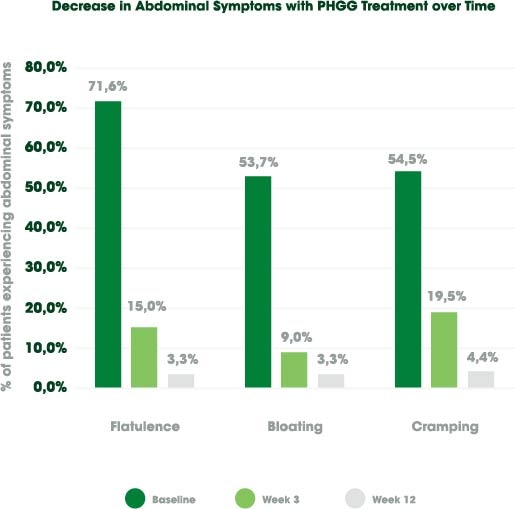
PHGG Reduces Abdominal Pain and Bloating in Chronically Constipated Patients
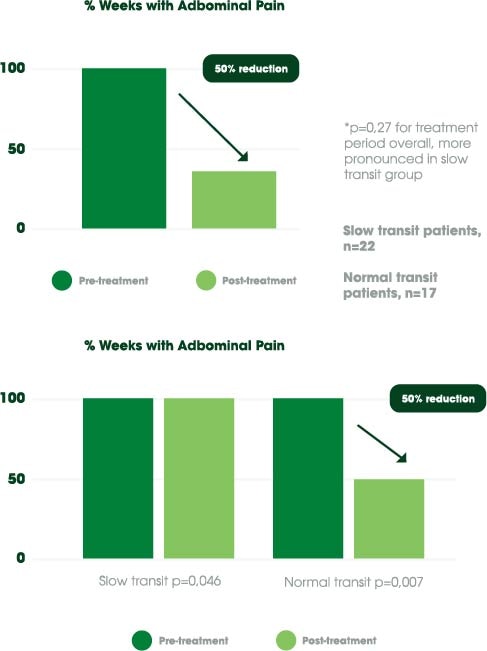
PHGG Reduces Abdominal Pain and Bloating in Chronically Constipated Patients
Polymeros D, et al. Dig Dis Sci 2014;59(9):2207-2214
In 39 patients with chronic constipation, supplementation with 5 grams of PHGG per day for 4 weeks resulted in a 50% reduction in abdominal pain and bloating (pre-treatment vs. post-treatment period). Those patients with a normal transit time experienced a greater benefit of PHGG for abdominal bloating.
PHGG is Safe and Well Tolerated in Healthy Adults
PHGG is Safe and Well Tolerated in Healthy Adults
Anderson SA and Fisher KD. Fed Am Soc Exp Biol 1993;1-61.
Takahashi H, et al. Nutr Res 1993 ;13: 649-657.
An expert panel for the Life Sciences Research Office of the Federation of American Societies for Experimental Biology concluded that consumption of PHGG of up to 20 grams per day added to conventional foods is safe with other research supporting good tolerance levels up to 40 grams daily in healthy adults.

